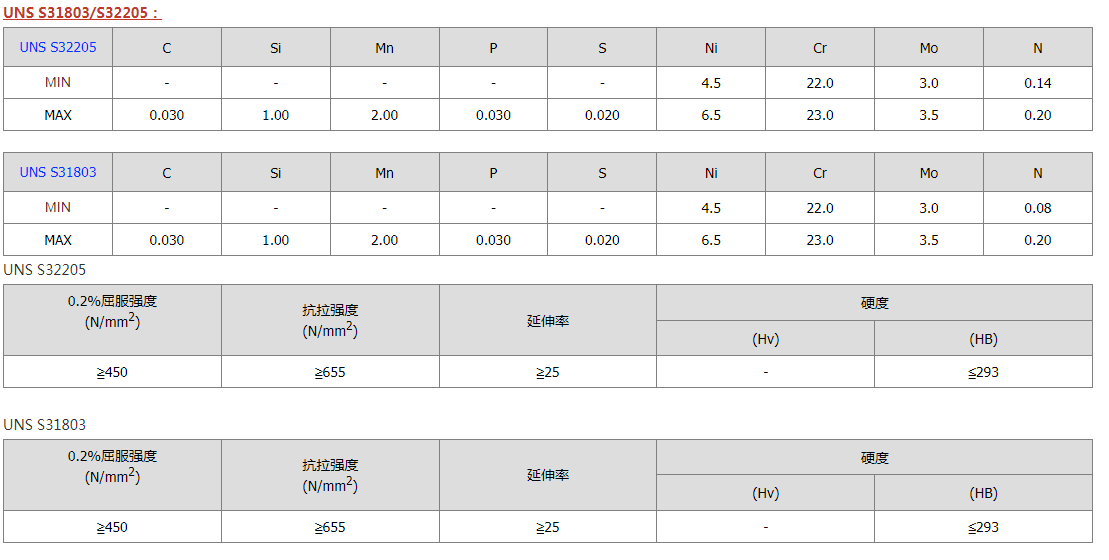The high amounts of molybdenum and chromium content in 2205 offer strength, improved pitting and consistent stress corrosion cracking resistance. 2205 integrates the best features of austenitic and ferritic steels (as well as nearly equal amounts of austenite and ferrite) and can be welded with common stainless steel welding techniques – its uniform composition minimizes localized corrosion.
Specifications - Duplex 2205
-
ASTM: A790, A815, A182
-
ASME: SA790, SA815, SA182
What is Duplex 2205?
Duplex 2205 is a type of stainless steel that belongs to the family of duplex stainless steels, which are designed to have a combination of high strength and excellent corrosion resistance. Duplex 2205 is composed of a mixture of austenitic and ferritic phases, providing superior mechanical and corrosion resistance properties compared to traditional austenitic stainless steels.
Duplex 2205 has several advantages over other types of stainless steel, including:
Excellent corrosion resistance: Duplex 2205 offers superior resistance to pitting, crevice corrosion and stress-corrosion cracking compared to traditional austenitic stainless steels.
High strength: Duplex 2205 has higher strength than most other types of stainless steel, particularly in terms of its yield and tensile strength.
Good weldability: Duplex 2205 can be easily welded using conventional welding techniques, without affecting the properties of the material.
Good machinability: Duplex 2205 is relatively easy to machine, despite being a duplex stainless steel.
Duplex 2205 is commonly used in various industries such as chemical processing, oil and gas, pulp and paper, and marine applications. It is particularly suitable for use in corrosive environments where high strength and good corrosion resistance are required.
Overall, Duplex 2205 is an important material that offers a combination of strength, corrosion resistance, and ease of fabrication, making it a popular choice for various industrial applications.
Corrosion Resistance
Grade 2205 stainless steel exhibits excellent corrosion resistance, much higher than that of grade 316. It resists localized corrosion types like intergranular, crevice and pitting. The CPT of this type of stainless steel is around 35°C. This grade is resistant to chloride stress corrosion cracking (SCC) at temperatures of 150°C. Grade 2205 stainless steels are apt replacements to austenitic grades, especially in premature failure environments and marine environments.
The super duplex gradesare even more resistant to corrosion.
Heat Resistance
-
The high chromium content of duplex stainless steels that protects against corrosion, causes embrittlement at temperatures over about 300°C.
-
At low temperatures duplex stainless steels have better ductility than the ferritic and martensitic grades. Duplex grades can readily be used down to at least -50°C.
Fabrication
Fabrication of all stainless steelsshould be done only with tools dedicated to stainless steel materials. Tooling and work surfaces must be thoroughly cleaned before use. These precautions are necessary to avoid cross contamination of stainless steel by easily corroded metals that may discolour the surface of the fabricated product.
Welding
Most standard welding methods suit this grade, except welding without filler metals, which results in excess ferrite. AS 1554.6 pre-qualifies welding for 2205 with 2209 rods or electrodes so that the deposited metal has the right balanced duplex structure.
Adding nitrogen to the shielding gas ensures that adequate austenite is added to the structure. The heat input must be maintained at a low level, and the use of pre or post heat must be avoided. The co-efficient of thermal expansion for this grade is low; hence the distortion and stresses are lesser than that in austenite grades.
Machinability
Although machinable, the high strengths of duplex stainless steels makes machining difficult. As an example, machining of 2205 is around 20% slower than for 304.
Machining can be enhanced by using the following rules:
-
Cutting edges must be kept sharp. Dull edges cause excess work hardening.
-
Cuts should be light but deep enough to prevent work hardening by riding on the surface of the material.
-
Chip breakers should be employed to assist in ensuring swarf remains clear of the work
-
Low thermal conductivity of austenitic alloys results in heat concentrating at the cutting edges. This means coolants and lubricants are necessary and must be used in large quantities.
Heat Treatment
Duplex stainless steelscannot be hardened by heat treatment. They can however be work hardened.
Solution treatment or annealing can be done by rapid cooling after heating to around 1100°C.
Weldability
Duplex stainless steelshave good weldability. All standard welding processes can be used. They are not quite as easily welded as the austenitic grades but low thermal expansion in duplex grades reduces distortion and residual stresses after welding. The recommended filler material for 2205 stainless steelis 2209.
Grade Reasons for choosing the grade
-
904L -Better formability is needed, with similar corrosion resistance and lower strength.
-
UR52N+ High resistance to corrosion is required, e.g. resistance to higher temperature seawater.
-
6%Mo - Higher corrosion resistance is required, but with lower strength and better formability.
-
316L - The high corrosion resistance and strength of 2205 are not needed. 316L is lower cost.
